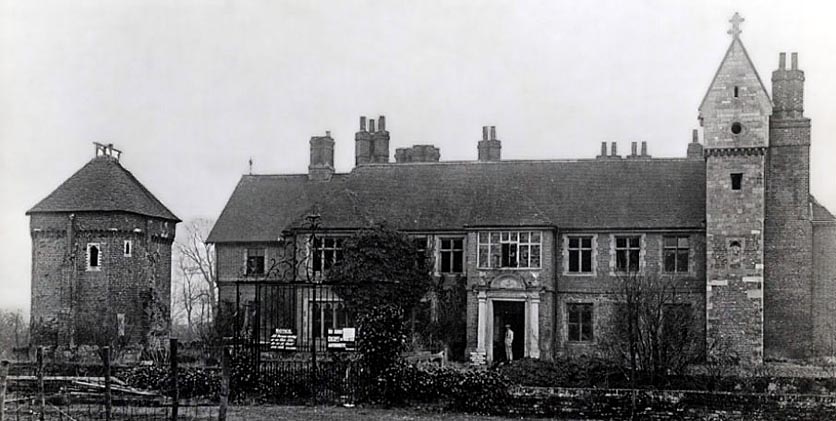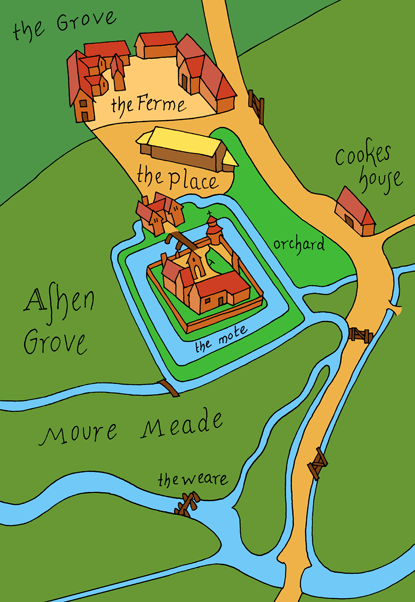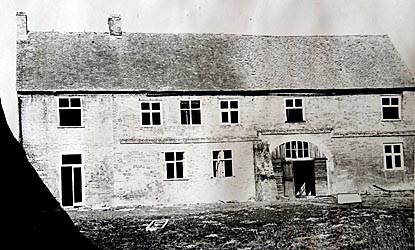
Although
owners of Southcote House (or Manor) are known as far back as the Saxon
Brictward who lived in the reign of Edward the
Confessor, it is not clear how
often they were in residence until the building of the first house platform and
associated residence in the early 13th century. It had a large inner moat and a
smaller outer one fed by the nearby Holy Brook. This seems to have been
constructed for the Belet family who originally came from another moated manor,
Balsdon Castle at Inglewood in Kintbury, at the other end of the county. Michael
Belet was apparently in residence at Southcote in 1337, when he established a
rabbit warren there to feed his household. His probable daughter and heiress,
Alice, married Thomas Restwold, perhaps a younger brother of Ralph Restwold of
High Head Castle in Cumberland, whose main southern home was the small manor of
Lee in Sindlesham. Their grandaughter and heiress, Lucy, married Laurence Drewe
(d.1417) of Seagry in Wiltshire, King’s Attorney to King Richard II and a member of his Royal
Council. He was at the head of much of the legal administration of the King’s
affairs at the end of his reign, including organising equipment for the famous
Irish expedition and reporting its progress to Parliament. He was lucky to
survive the King’s unhappy demise, but, after a short period in custody, was
able to live a more rural life in Berkshire and Wiltshire. In 1387, he was fined
for failing to repair a causeway and associated ditch at Southcote (presumably
that which still exists just south-east of the site), as well as
the ‘Stokyng Bridge’. His granddaughter and heiress, Margaret,
married Walter Sambourne of Fernham, part of Shrivenham, in North Berkshire, and
Lushill, just over the border in Wiltshire. It was probably Walter who, around
1450, built the first of the structures that survived as part of the early 20th
century complex: the arch-braced south wing and chapel, three chalk cellars and
the north-eastern brick guard-tower. It is often supposed that there was
originally a tower at each corner of the platform connected by the surrounding
wall, but there seems to be no clear evidence for this. There was, however, a
large manor house built around a courtyard, probably with a small towered
entrance and at least one grand bay window to catch the morning Sun.
 In the early sixteenth century, Walter’s great granddaughter, Margaret
Sambourne, married William, 2nd Baron Windsor. The couple lived at their much grander residences
at Bradenham in Buckinghamshire and Southcote was rented out to tenants. In 1595, their
grandson sold the place to Anthony Blagrave of Old Bulmershe Court in
Woodley.
His father, John, had established the family’s fortunes around Reading when he
inherited considerable former abbey property from his step-father, William Grey.
Anthony remained at Bulmershe, but, in 1596, leased Southcote to his younger
brother, John, for nine-six years. He was a well-known and respected
mathematician of the age, as well as an early accurate map-maker. He wrote
several books, at least one at Southcote, and left a sketch of the house and its
associated buildings which has
survived. It probably shows his rebuilding of much of the medieval structure,
with large gatehouse, two southern and western wings and a north-eastern
‘Solar Tower’ where he apparently pursued his study of the heavens. This was
almost certainly the detached building at the eastern end of the later main
frontage. It was demolished around 1900. In his will (1611), John Blagrave
refers to Southcote House as “my old dwelling house at Southcote which
was first builded”. Perhaps he found the medieval parts of the building a little
restrictive and old fashioned, for, by this time, he was living at Southcote
Lodge, a dwelling he had recently erected. Presumably, this was on the site of the present
house of that name, on edge of the estate, off the
Burghfield Road. Mervyn Tuchet, 4th Earl of Castlehaven, a nephew of Lady Davies
of Englefield House, was living there in 1665. It was later in the hands of the
Noakes from the Castle Brewery. The current building, originally called
Calvespit House, was probably built by their eventual heir, George Noyes, in the mid-18th century. Gen.
Lawrence Shadwell (1823-1887), of Crimea fame, retired there.
In the early sixteenth century, Walter’s great granddaughter, Margaret
Sambourne, married William, 2nd Baron Windsor. The couple lived at their much grander residences
at Bradenham in Buckinghamshire and Southcote was rented out to tenants. In 1595, their
grandson sold the place to Anthony Blagrave of Old Bulmershe Court in
Woodley.
His father, John, had established the family’s fortunes around Reading when he
inherited considerable former abbey property from his step-father, William Grey.
Anthony remained at Bulmershe, but, in 1596, leased Southcote to his younger
brother, John, for nine-six years. He was a well-known and respected
mathematician of the age, as well as an early accurate map-maker. He wrote
several books, at least one at Southcote, and left a sketch of the house and its
associated buildings which has
survived. It probably shows his rebuilding of much of the medieval structure,
with large gatehouse, two southern and western wings and a north-eastern
‘Solar Tower’ where he apparently pursued his study of the heavens. This was
almost certainly the detached building at the eastern end of the later main
frontage. It was demolished around 1900. In his will (1611), John Blagrave
refers to Southcote House as “my old dwelling house at Southcote which
was first builded”. Perhaps he found the medieval parts of the building a little
restrictive and old fashioned, for, by this time, he was living at Southcote
Lodge, a dwelling he had recently erected. Presumably, this was on the site of the present
house of that name, on edge of the estate, off the
Burghfield Road. Mervyn Tuchet, 4th Earl of Castlehaven, a nephew of Lady Davies
of Englefield House, was living there in 1665. It was later in the hands of the
Noakes from the Castle Brewery. The current building, originally called
Calvespit House, was probably built by their eventual heir, George Noyes, in the mid-18th century. Gen.
Lawrence Shadwell (1823-1887), of Crimea fame, retired there.
The will of John the Mathematician was so complicated and exact that a
considerable time was spent in deciphering it to the complete satisfaction of
the legatees. The lease of Southcote was left to his brother, Alexander, and
then his sons, in a particular order. Alexander only outlived John by a year and
the next to inherit should have been Daniel Blagrave, but his elder brother,
John, managed to briefly take possession until the old
mathematician’s ghost appeared and told him to leave! And so the
rightful heir was able to take up residence at Southcote. Daniel Blagrave was a
Staple Inn attorney and almost certainly the man who instigated a major
rebuilding programme at Southcote, perhaps when he came of age in 1624. This
included the building of the main slightly e-planned northern frontage, so
well-known from old photographs. He was elected MP for Reading in 1640, which
did not place him in good standing with the King when the Civil War began two
years later. The Royalists were initially in charge of Reading, so Daniel was
ejected from Southcote and it was handed over to one more sympathetic to their
cause. However, during the subsequent siege of the town by Parliamentary forces,
Daniel was able to take back his home, allowing the Earl of Essex to make it his
headquarters when he arrived on the scene in in April 1643. He is said to have
held a Council of War in the old oak panelled room before marching to raise the
siege. One can imagine the figures of Cromwell, John
Hampden, Essex and Blake,
all stern visaged and immobile, sitting at a documented table, their faces
clouded with care and anxiety, while standing about the tables are officers with
strange and worried looks. Daniel later became one of the infamous Regicides and
was obliged
to flee abroad after the Restoration.
Daniel Blagrave’s family lived mostly in London and never recovered the lease of
Southcote. It seems to have reverted to the owner, Sir John, the son of Anthony
Blagrave, the original purchaser. He let his younger brother, Anthony, live at
Bulmershe and moved into Southcote himself. After his death in 1655, his widow,
Rose, Lady Blagrave, lived there for a while, before the Regicide's brother,
John, was allowed to move in. He was Steward to Sir
Bulstrode Whitelocke, and
was followed at the property by his son, Alexander, until his death in 1690. The
place then reverted to old Sir John's nephew, another John Blagrave. He favoured
Bulmershe, so other family members may have lived at Southcote House until it
was given to his second son, Anthony, and then the latter’s son, John.
By the 1750s, repairs at the old house at Southcote may have become increasingly
expensive. In 1759, John Blagrave purchased Calcot Park in
Tilehurst from the
heartbroken Benjamin Child. He remained at Southcote for only a few years more
while Calcot’s water-damaged house was rebuilt. It was during this time that
his father-in-law, Sir George Cobb baronet, accidentally fell in the moat and
was drowned on 29th March 1762. He was an old man of ninety. Perhaps this sad
event finally persuaded the Blagraves to leave Southcote and never return.
 The family
continued to own the manor house, but rented it out to tenants. In 1813, it was
empty. From 1828 until
1850, it was the home of Charles and Frances Lutyens and, briefly afterwards, of
their son, also Charles, who had been born there. The latter became the father of the
famous architect, Edwin Lutyens. It is tempting to think that he may have
visited the old family home and been inspired by the architecture - perhaps when
building Deanery Gardens in Sonning.
After the death of the Governor of Jersey, Major-General Godfrey Mundy in 1860,
his widow, Louisa, moved to Southcote House with her two young sons. She was the
niece of the Earl of Carnarvon from Highclere Castle, near Newbury.
The eccentric
recluse, Wastel Brisco (1824-1891), was living there in the 1870s and 80s, when he spent
considerable sums in renovating the dilapidated parts, particularly the
exterior. In 1891, he pulled down the south-western timber chapel and had a
large twin-gabled seven-bay west-wing built. Presumably this was the large
ball-room often referred to. The interesting so-called 'clock' tower on the west
side of the main facade (with little sign of a clock) was also his work.
However, the full plan was never completed as he died on 2nd October that year ,
in the middle of the construction schedule. Ten years later, there was only a caretaker living there when the
Blagraves tried to sell the place. They were, however, unsuccessful due to it
being in need of extensive maintenance. Despite continuing decay, the local
people had a great fascination for the old house and it was often visited by
interested groups. However, when demolition was proposed, their outcry was not
enough to prevent it and the house was demolished in 1921. The large stable
block-cum-gatehouse outside the moat remained until 1960, but eventually went the same way.
There was a small excavation of the site prior to the present flats being built
within the, now dry, moat in 1964. Only this medieval defensive measure remains
today to reminder us of the site’s former grandeur.
The family
continued to own the manor house, but rented it out to tenants. In 1813, it was
empty. From 1828 until
1850, it was the home of Charles and Frances Lutyens and, briefly afterwards, of
their son, also Charles, who had been born there. The latter became the father of the
famous architect, Edwin Lutyens. It is tempting to think that he may have
visited the old family home and been inspired by the architecture - perhaps when
building Deanery Gardens in Sonning.
After the death of the Governor of Jersey, Major-General Godfrey Mundy in 1860,
his widow, Louisa, moved to Southcote House with her two young sons. She was the
niece of the Earl of Carnarvon from Highclere Castle, near Newbury.
The eccentric
recluse, Wastel Brisco (1824-1891), was living there in the 1870s and 80s, when he spent
considerable sums in renovating the dilapidated parts, particularly the
exterior. In 1891, he pulled down the south-western timber chapel and had a
large twin-gabled seven-bay west-wing built. Presumably this was the large
ball-room often referred to. The interesting so-called 'clock' tower on the west
side of the main facade (with little sign of a clock) was also his work.
However, the full plan was never completed as he died on 2nd October that year ,
in the middle of the construction schedule. Ten years later, there was only a caretaker living there when the
Blagraves tried to sell the place. They were, however, unsuccessful due to it
being in need of extensive maintenance. Despite continuing decay, the local
people had a great fascination for the old house and it was often visited by
interested groups. However, when demolition was proposed, their outcry was not
enough to prevent it and the house was demolished in 1921. The large stable
block-cum-gatehouse outside the moat remained until 1960, but eventually went the same way.
There was a small excavation of the site prior to the present flats being built
within the, now dry, moat in 1964. Only this medieval defensive measure remains
today to reminder us of the site’s former grandeur.
Click
here for a 1905 Description of Southcote House






 In the early sixteenth century, Walter’s great granddaughter, Margaret
Sambourne, married William, 2nd Baron Windsor. The couple lived at their much grander residences
at Bradenham in Buckinghamshire and Southcote was rented out to tenants. In 1595, their
grandson sold the place to Anthony
In the early sixteenth century, Walter’s great granddaughter, Margaret
Sambourne, married William, 2nd Baron Windsor. The couple lived at their much grander residences
at Bradenham in Buckinghamshire and Southcote was rented out to tenants. In 1595, their
grandson sold the place to Anthony  The family
continued to own the manor house, but rented it out to tenants. In 1813, it was
empty. From 1828 until
1850, it was the home of Charles and Frances Lutyens and, briefly afterwards, of
their son, also Charles, who had been born there. The latter became the father of the
famous architect, Edwin Lutyens. It is tempting to think that he may have
visited the old family home and been inspired by the architecture - perhaps when
building Deanery Gardens in
The family
continued to own the manor house, but rented it out to tenants. In 1813, it was
empty. From 1828 until
1850, it was the home of Charles and Frances Lutyens and, briefly afterwards, of
their son, also Charles, who had been born there. The latter became the father of the
famous architect, Edwin Lutyens. It is tempting to think that he may have
visited the old family home and been inspired by the architecture - perhaps when
building Deanery Gardens in